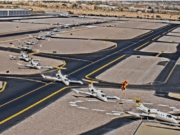
The following information provides an awareness of problems that might be avoided in the future. The information is based on final reports by official investigative authorities on aircraft accidents and incidents.
 Jets
Jets
Pilots Did Not Use CTAF
Hawker Beechcraft 400XP. Substantial damage. No injuries.
The flight crew was conducting a charter flight with five passengers from Monterrey, Mexico, to Telluride, Colorado, U.S., the afternoon of Dec. 23, 2015. Instrument meteorological conditions (IMC) prevailed at the non-towered destination airport, and the pilots had discussed diverting to their alternate airport if they were unable to land there.
The approach controller was providing vectors to sequence the Hawker for an instrument approach to Telluride when airport personnel issued a notice to airmen (NOTAM) advising that the runway was being closed immediately for snow removal. “Although the NOTAM was electronically routed to the controller, the controller’s system was not designed to automatically alert the controller of a new NOTAM,” said the report by the U.S. National Transportation Safety Board (NTSB). “The controller needed to select a display screen on the equipment that contained the information.”
The flight crew canceled their instrument flight rules flight plan after acquiring visual contact with the runway, but they did not announce their position and intentions on the common traffic advisory frequency (CTAF), which was being monitored by airport personnel and the snowplow operator.
The pilots did not see the snowplow in time to avoid colliding with it. The Hawker’s right wing separated when it struck the snowplow about halfway down the runway. The airplane came to a stop off the side of the runway. Damage to the snowplow was characterized as minor. There were no injuries.
NTSB concluded that the probable cause of the accident was “the limitations of air traffic control equipment that prevented the controller’s timely recognition of NOTAM information that was effective immediately.” The report said that the controller’s heavy workload and the pilots’ “omission to monitor and transmit their intentions on the [CTAF]” were contributing factors.
Pilot Struck by Cabin Door
Gulfstream G150. Substantial damage. One fatality, one minor injury.
The pilots and the cabin assistant were preparing the G150 for a positioning flight from Kittilä, Finland, to Yekaterinburg, Russia, the afternoon of Jan. 4, 2018. The temperature on the ramp was minus 22 degrees C (minus 8 degrees F).
The G150 had been parked outside for two days. The copilot was brushing off snow that had accumulated on the aircraft when the captain entered the cockpit and started the auxiliary power unit (APU) to provide bleed air to heat the cabin. According to the report by the Safety Investigation Authority of Finland, the captain did not ensure that the cabin pressurization outflow valve was open before starting the APU. He had closed the valve after arriving in Kittilä to prevent blowing snow from entering the system.
After starting the APU, the captain exited the aircraft and closed the cabin door. “The volume of the APU’s bleed air is great when compared to, for example, the volume of bleed air generated by both engines running simultaneously,” the report said. With the outflow valve and the cabin door closed, the bleed air was trapped inside the aircraft and began to rapidly pressurize the cabin.
The cabin assistant, who was working inside the cabin, felt pressure building in her ears and chest. She knocked on a cockpit window to attract the pilots’ attention. The pilots heard the knocks and saw that the cabin assistant appeared to be in distress. The captain attempted to open the cabin door. “According to the copilot’s observations, it was unusually difficult for the captain to get the door open,” the report said. “Then the captain pulled harder on the door handle, at which time the door blew open with excessive force, hitting the captain, who was standing underneath the door, and knocking him to the ground.”
The copilot, who was standing near the captain, was knocked onto his back by the pressure wave emitted when the door was opened. The cabin attendant, who was moving from the cockpit into the cabin, was blown against the forward bulkhead. The copilot radioed for help and then began cardiopulmonary resuscitation (CPR) of the captain. The airport ramp supervisor arrived shortly thereafter and participated in the CPR efforts.
Ambulances arrived about 10 minutes later. The captain was declared dead by a physician, and the cabin assistant was treated for bruises and diagnosed as having suffered a mild concussion. The copilot was not injured. The G150’s cabin was substantially damaged, and there was minor damage to the cabin door.
‘Trying to Get to Clear Skies’
Cessna Citation CJ1. Destroyed. Two fatalities.
Shortly after departing in IMC from Salt Lake City, Utah, U.S., the morning of Jan. 18, 2016, the pilot told air traffic control (ATC) that the airplane’s flight management system had failed and that he was “trying to get to clear skies.” The controller was providing vectors toward visual meteorological conditions when the pilot advised that he was “losing instruments” and wanted to “get clear of the weather.”
“Radar data indicated that during the 10-minute flight, the airplane conducted a series of climbs and descents with large variations in airspeed,” the NTSB report said. “About two minutes before radar contact was lost, the airplane entered a climbing right turn, reaching its highest altitude of 21,000 ft before it began a rapidly descending and tightening turn.” The Citation broke up while descending — reaching a peak descent rate of 36,000 fpm — and subsequently struck terrain in Cedar Fort, Utah. The pilot and his passenger were killed.
Investigators were unable to determine what caused the equipment problems reported by the pilot. “The airplane was equipped with three different sources of attitude information, all three of which were powered by separate sources,” the report said. “It is unlikely that all three sources would fail simultaneously. … Further, the pilot would have been afforded heading information from the airplane’s standby compass.”
NTSB concluded that the probable cause of the accident was spatial disorientation. “As a single pilot operating without the assistance of an additional crewmember in a high-workload, high-stress environment, the pilot would have been particularly susceptible to distraction and ultimately a loss of airplane control due to spatial disorientation,” the report said.
Icing Affects Airspeed Indications
Boeing 787-8. No damage. No injuries.
The 787 was en route from Melbourne, Australia, to Singapore the afternoon of Dec. 21, 2015, when it encountered ice-crystal icing conditions at Flight Level 400 (approximately 40,000 ft) just north of the Australian coast. The icing conditions affected all three of the aircraft’s pitot-static systems, said the report by the Australian Transport Safety Bureau.
“The airspeed indications became erratic,” the report said. “As a result, the autopilot disconnected and the primary flight control [system] reverted to a mode with fewer automated functions and protections.”
The flight crew maintained an appropriate airspeed by holding a pitch attitude and thrust setting prescribed by the “Airspeed Unreliable” checklist. Although the airspeed indications soon returned to normal, the flight control system remained in the secondary mode and the autopilot and autothrottle systems could not be re-engaged. “The aircraft had to be manually flown for the remainder of the flight,” the report said. “Because of this, the crew diverted the aircraft and made an uneventful landing in Darwin, Australia.”
The report said that Boeing has revised the 787’s flight control software to reduce the possibility of reversion to the secondary mode when indicated airspeed becomes erratic only briefly. Additional software revisions were intended to reduce the risk that a flight crew might make inappropriate, large elevator control inputs in response to a sudden, false decrease in indicated airspeed.
 Turboprops
Turboprops
‘Heading Is Not Engaged’
Beech King Air B200. Destroyed. Ten fatalities.
Visibility was 800 m (1/2 mi) in fog when the King Air departed from New Delhi, India, to transport government border-security personnel to Ranchi the morning of Dec. 22, 2015. The flight crew engaged the autopilot immediately after liftoff but did not select the heading mode, said the report by a committee of inquiry established by India’s Ministry of Civil Aviation.
Noting that both pilots had relatively low flying experience, particularly in King Airs, the report said, “This hurried and nonstandard action by the flight crew of engaging the autopilot immediately after liftoff reveals their eagerness to let the aircraft be flown by the autopilot and underlines their inability to fly the aircraft manually until autopilot engagement height was achieved.” The airline prescribed a minimum autopilot-engagement height of 500 ft above ground level (AGL).
The aircraft was in a slight left bank when the autopilot was engaged. With no lateral mode selected on the autopilot, the King Air continued turning left with an increasing bank angle. The aircraft was at about 400 ft AGL, with the left bank angle increasing through 45 degrees, when the pilot monitoring said, “What are you doing? … Please maintain direction. … Heading is not engaged.”
The pilot flying replied, “Not engaged. I will take manual [control].” Shortly thereafter, the cockpit voice recorder captured automated warnings of autopilot disengagement, low altitude, high bank angle and an impending stall. The King Air then struck trees, the airport perimeter wall and a holding tank at a water-treatment plant. All seven passengers and the three crewmembers were killed, and the King Air was destroyed by the impact and post-impact fire.
Visibility ‘Getting Fuzzy’
Cessna 208B. Substantial damage. Five serious injuries, three minor injuries.
The pilot was conducting a charter flight under visual flight rules from Fairbanks, Alaska, U.S., to Anaktuvuk Pass the morning of Jan. 2, 2016. The pilot later told investigators that visibility began “getting fuzzy” as the Caravan neared the destination at about 10,000 ft.
“The pilot then descended the airplane to 2,500 ft (500 ft AGL) to fly along a river,” the NTSB report said. “When the airplane was about 10 miles [16 km] southwest of the airport, he climbed the airplane to about 3,000 ft [airport traffic pattern altitude] in order to conduct a straight-in approach to the runway.” However, the pilot did not establish visual contact with the airport due to the snow and clouds. “The pilot also noted that flat-light conditions limited his ability to determine his distance from the surrounding mountainous, snow-covered terrain,” the report said.
Four passengers and the pilot were seriously injured, and three passengers sustained minor injuries when the Caravan struck rising terrain about 6 mi (10 km) southwest of the airport. One of the passengers used a cellphone to call for help. Rescue personnel reached the accident site 20 minutes later.
Severe Icing Triggers Upset
ATR 72-212A. Minor damage. No injuries.
The ATR was climbing through 5,300 ft during a flight from Guernsey, Channel Islands, to Manchester, England, the evening of Dec. 21, 2016, when the flight crew activated the aircraft’s anti-ice systems. They activated the deicing systems when the aircraft encountered icing conditions at 9,000 ft.
Shortly thereafter, the crew received a cautionary message of degraded aircraft performance and an advisory to increase airspeed. The commander activated the external ice light and commented, “We’ve got a bit, haven’t we,” referring to a buildup of ice on the wing leading edges. The pilots consulted the quick reference handbook, but “the appropriate checklists were not fully actioned and the correct climb speed [175 kt] was not maintained because the crew focused on climbing the aircraft clear of the cloud and icing conditions,” said the report by the U.K. Air Accidents Investigation Branch.
When the commander increased airspeed from 165 kt to 175 kt, the climb rate decreased from 420 fpm to about 25 fpm. He then reduced airspeed to 165 kt again and told the copilot that he wanted to “see if we can get above [the clouds].” The climb rate increased to 200 fpm, but the crew again received an advisory to increase airspeed.
The commander said, “We are picking up quite a bit of ice actually,” and increased airspeed to 175 kt. The ATR subsequently descended at 540 fpm until leveling off at 12,000 ft. Airspeed again was reduced to 165 kt, and the aircraft slowly began to climb.
“As it was apparent that the aircraft had insufficient performance to reach its cruising level of [17,000 ft], the crew made a request to ATC to level off at [13,000 ft] so the aircraft could accelerate before resuming the climb,” the report said.
ATC approved the request and instructed the crew to fly directly to a waypoint that would lessen the remaining distance to the airport. The commander was establishing level flight at 13,000 ft and turning 10 degrees toward the assigned waypoint when the aircraft experienced an in-flight upset. The autopilot automatically disengaged when the ATR rolled 32 degrees left and 38 degrees right. The aircraft rolled left again, reaching a bank angle of 73 degrees, stalled and pitched 16 degrees nose-down.
“Upon the commander’s instructions, the copilot actioned the upset recovery items, [which] included extending the flaps to Flap 15,” the report said. The aircraft descended 1,000 ft before the commander recovered control. The crew declared an emergency and returned to Guernsey, where the ATR was landed without further incident. Examination of the aircraft revealed minor overspeed damage to the flaps.
 Piston Airplanes
Piston Airplanes
Cabin Heater Causes Explosion
Cessna 340. Destroyed. One fatality.
The pilot had completed an air-sampling flight over oil fields and was returning to Fargo, North Dakota, U.S., the afternoon of Dec. 1, 2016. While receiving vectors from ATC for an instrument landing system approach to the airport, the pilot reported an in-flight fire.
“The airplane lost altitude rapidly, and radar contact was lost,” the NTSB report said. The airplane struck terrain 10 mi (16 km) south of the airport. “Both nose baggage compartment doors were found about 2 miles [3 km] south of the main wreckage, which indicated that they came off at nearly the same time and most likely before the pilot’s distress call.”
Examination of the wreckage revealed a loose fuel fitting on the cabin heater, which was in the nose compartment, and soot on the windshield. Investigators determined that fuel likely had leaked from the loose fitting, causing fuel vapors to build inside the nose compartment; the vapors likely were ignited by the cabin heater, resulting in an explosion that caused the baggage doors to separate and an in-flight fire.
Engine Fails on Approach
Piper Chieftain. Destroyed. Four fatalities.
The Chieftain departed from Jayapura, Papua, Indonesia, the morning of Jan. 19, 2014, for a positioning flight to Surabaya, East Java, where maintenance was to be performed. Several fuel stops were planned; the first was at Langgur, Maluku. The pilot’s flight plan said that the first leg would comprise 3.5 hours and that the aircraft had enough fuel to fly for six hours.
As the aircraft neared Langgur, the pilot was advised that thunderstorms and heavy rain prevailed at the airport. The pilot reported that the Chieftain was 25 nm (46 km) northeast of the airport at 2,500 ft and requested, and received, clearance to use Runway 27. ATC attempted to contact the pilot five minutes later, but there was no reply.
The Chieftain struck terrain 2 nm (3 km) northeast of the airport, killing the pilot and his three passengers. The report by the Indonesian National Transportation Safety Committee did not specify whether the accident occurred while the pilot was flying a visual approach or the published nondirectional beacon (NDB) approach to the airport.
The Chieftain did not have, and was not required to have, a flight data recorder or cockpit voice recorder, and radio communications between the pilot and ATC were not recorded. Because of the absence of this information and the extent of aircraft damage, “information for the investigation was limited,” the report said.
“Based on the available evidence, the investigation concluded that the left engine failed during approach” and that the pilot did not subsequently feather the left propeller. The resulting asymmetric forces caused the pilot to lose control of the aircraft, the report said. The cause of the engine failure was not determined, but investigators ruled out fuel exhaustion due to the extent of the post-impact, fuel-fed fire.
Loose Battery Emits Smoke
Piper Navajo. Minor damage. No injuries.
The Navajo encountered turbulence during a charter flight from Pafuri Camp, South Africa, to Johannesburg the afternoon of Jan. 1, 2018. As the aircraft neared the destination, smoke appeared in the cockpit. The flight crew declared an urgency and expedited their landing at O.R. Tambo International Airport, said the report by the South African Civil Aviation Authority.
Examination of the aircraft revealed minor heat damage to the battery box. Investigators determined that the battery housing had not been secured properly and that the battery had been displaced by the turbulence. The battery terminals made contact with the lid of the metal battery box, causing electrical arcing and smoke, the report said.
 Helicopters
Helicopters
Ice Blocks Carburetor
Robinson R22. Substantial damage. Two fatalities.
The pilot was circling the harbor in San Pedro, California, U.S., the night of Jan. 4, 2017, while his passenger took aerial photographs of several cruise ships. Witnesses on one ship saw the R22 enter a spin and descend almost vertically into the water. Both occupants were killed.
Examination of the helicopter revealed that the carburetor heat control was in the “OFF” position and that the main rotor was turning slowly on impact, the NTSB report said. Investigators determined that the engine likely had lost power due to carburetor icing and that the main rotor blades had slowed and stalled.
“The meteorological conditions at the time of the accident were conducive for the formation of carburetor ice,” the report said. “It is likely that the pilot’s failure to apply carburetor heat resulted in a loss of engine power due to carburetor ice. … If the pilot had maintained main rotor rpm, he might have been able to make a successful autorotation and touch down less violently on the water.”
Loose Fuel Line
Eurocopter EC130-B4. Substantial damage. No injuries.
The pilot was conducting an approach to Boulder City (Nevada, U.S.) Municipal Airport during a post-maintenance test flight the afternoon of Jan. 1, 2014, when the low-fuel-pressure warning light illuminated and the engine flamed out.
“The pilot lowered the collective to initiate an autorotation,” the NTSB report said. “However, due to the low altitude and airspeed, the helicopter subsequently landed hard and rolled over.” The fuselage and tail boom were substantially damaged, but the pilot was not hurt.
Examination of the EC130 revealed that the nut on the main fuel supply line fitting was loose. The fitting had been removed to defuel the helicopter during maintenance and subsequently had not been tightened properly and safety-wired, the report said. This “allowed it to back off due to normal engine vibration and resulted in interruption of the fuel flow during flight.”
Rotor Stalls During Autorotation
Robinson R22. Substantial damage. One fatality, one serious injury.
Three approaches and landings were completed during a dual instructional flight in Lake Worth, Florida, U.S., the morning of Dec. 29, 2014, before a practice autorotational landing was initiated. The student pilot told investigators that the flight instructor attempted to increase power at 100 ft to recover from the autorotation, but the engine did not respond.
The R22 descended rapidly and struck terrain near the approach end of the runway, killing the flight instructor and seriously injuring the student pilot. Examination of the helicopter and a test-run of the engine revealed no mechanical anomalies that would have precluded normal operation, the NTSB report said.
Investigators found a discrepancy between guidance provided by the flight school and by Robinson for practice autorotations. “The flight school’s published procedure for practice autorotations instructed the pilot to initiate the maneuver first by lowering the collective, then reducing the throttle to idle,” the report said. “The practice of reducing the throttle to idle was contrary to the manufacturer’s guidance for this maneuver, which stated that the throttle should be adjusted only enough to allow for a small tachometer needle separation in order to reduce the chance of inadvertent engine stoppage during the maneuver.”
NTSB concluded that the probable cause of the accident was “a main rotor stall due to low rotor rpm, which resulted in an uncontrolled descent into terrain” and that a contributing factor was “the flight instructor’s delayed remedial action.”
| Date | Location | Aircraft Type | Aircraft Damage | Injuries |
|---|---|---|---|---|
| NA = not available This information, gathered from various government and media sources, is subject to change as the investigations of the accidents and incidents are completed. |
||||
| Oct. 1 | Uriman, Venezuela | Antonov 2T | substantial | 2 NA |
| The flight crew conducted a forced landing in the jungle after the engine lost power. | ||||
| Oct. 3 | Khartoum, Sudan | Antonov 26, 32 | substantial | none |
| Both aircraft were on a training mission for the Sudanese air force when the An-26, which was rolling out on landing, was struck from behind by the An-32, which also had been cleared to land. | ||||
| Oct. 6 | Salinas, California, U.S. | Robinson R44 | substantial | l none |
| The main rotor blades severed the tail boom during a forced landing in a field following a partial loss of engine power on takeoff. | ||||
| Oct. 7 | Bridgeville, Delaware, U.S. | Enstrom F28 | substantial | 4 none |
| Engine and rotor speed decreased below minimums as the pilot maneuvered to clear power lines while taking off from a field on a sightseeing flight. The F28 then descended and touched down hard. | ||||
| Oct. 10 | Beoga, Papua, Indonesia | Cessna 208B | substantial | 2 NA |
| The Caravan struck an embankment while landing. | ||||
| Oct. 10 | Yakutsk, Russia | Sukhoi 100-95B | substantial | 91 NA |
| No fatalities were reported when the Superjet overran a wet runway while landing with a 4-kt tailwind and a deactivated right-engine thrust reverser. | ||||
| Oct. 12 | Tiruchirapalli, India | Boeing 737-800 | substantial | 136 none |
| The 737’s lower fuselage struck the localizer antenna and a brick wall during takeoff for a flight to Dubai. The flight crew diverted to Mumbai and landed without further incident. | ||||
| Oct. 12 | Lagos, Nigeria | ATR 72-202 | destroyed | none |
| A fire erupted while the aircraft was undergoing maintenance. | ||||
| Oct. 13 | Westhampton Beach, New York, U.S. | Piper Seneca | substantial | 3 fatal |
| Instrument meteorological conditions prevailed when the Seneca broke up in flight while being vectored to an airport with visual meteorological conditions (VMC). The airplane had departed under visual flight rules from Danbury, Connecticut, for a flight to Charleston, South Carolina. The pilot had been cleared to climb to 8,500 ft. The Seneca was climbing through 15,700 ft when the pilot told air traffic control (ATC) that he was “trying to maintain VMC” and that the attitude indicator was “unreliable.” Shortly after ATC told the pilot to turn west, the airplane entered a rapid descent, broke up and struck the ocean about 1/2 mi (1 km) offshore. | ||||
| Oct. 17 | Fulton, Missouri, U.S. | Robinson R22 | destroyed | 1 fatal |
| Witnesses saw the R22 flying low and apparently in distress before it struck terrain during a solo instructional flight. | ||||
| Oct. 28 | Santa Cruz, Bolivia | Cessna 340 | destroyed | 2 none |
| The 340 struck trees and terrain while the pilot was attempting to return to a private airstrip after encountering engine problems on takeoff. | ||||
| Oct. 29 | Jakarta, Indonesia | Boeing 737-8 | destroyed | 189 fatal |
| VMC prevailed when the 737 struck the Kerawang Sea after the flight crew declared an emergency shortly after takeoff and attempted to return to the airport. Flight data transmitted by the aircraft were erratic, with altitudes varying from 4,500 ft to 5,350 ft, before the aircraft descended into the sea. Similar variations in altitude and airspeed had been transmitted during the 737’s previous takeoff. | ||||
| Nov. 2 | McDougal, Arkansas, U.S. | Hughes 500 | destroyed | 1 fatal, 2 minor |
| The pilot was killed and two linemen sustained minor injuries when the helicopter struck a utility pole and terrain during utility line maintenance. | ||||
| Nov. 4 | Uvalde, Texas, U.S. | Bell 206B | destroyed | 3 fatal |
| VMC prevailed when the JetRanger struck a 1,450-ft hill shortly after departing from a ranch. | ||||
| Nov. 7 | Halifax, Nova Scotia, Canada | Boeing 747-400F | substantial | 4 minor |
| The freighter overran the wet, 2,347-m (7,700-ft) runway while landing with a tailwind component of 8 kt. | ||||
| Nov. 8 | Vaskovo, Russia | Antonov 2R | destroyed | 14 NA |
| Two of the 14 occupants sustained unspecified injuries during a forced landing in a forest. The biplane had encountered icing conditions after departing on a scheduled flight to Mezen, and the flight crew was attempting to return to the airport when the engine lost power. | ||||
| Nov. 9 | Georgetown, Guyana | Boeing 757-200 | substantial | 1 fatal, 127 NA |
| One passenger was killed and six occupants sustained unspecified injuries when the 757 overran the runway while returning to land after hydraulic system problems were encountered during departure. | ||||
| Nov. 9 | Chakala, Pakistan | Lockheed C-130E | destroyed | 9 none |
| The aircraft, operated by the Pakistan air force, touched down hard on landing. A tire burst, and the C-130 veered off the side of the runway and struck a wall. All the occupants were able to exit the aircraft before it was destroyed by fire. | ||||
| Nov. 9 | Walton, New York, U.S. | Cessna 310R | destroyed | 1 fatal |
| The 310 was en route from Niagara Falls, N.Y., to Teterboro, N.J., in VMC at 7,000 ft when the pilot told ATC that he needed to get on the ground immediately. After the controller provided a heading to the nearest airport — Sidney, N.Y. — there were no further intelligible radio transmissions from the pilot. The airplane continued flying southeast at 7,000 ft for nearly an hour before it descended and struck terrain. | ||||
| Nov. 12 | Myrtle Beach, South Carolina, U.S. | Rockwell 690C | destroyed | 1 serious |
| The 690 struck the ocean on approach to Myrtle Beach. | ||||
| Nov. 16 | Clanton, Alabama, U.S. | Bell OH-58C | substantial | 2 fatal |
| The police helicopter was flying low over a river when it struck power lines and descended into the water. | ||||
| Nov. 18 | Harmon, North Dakota, U.S. | Cessna 441 | destroyed | 3 fatal |
| Night VMC prevailed when the 441 struck terrain during an emergency medical services flight. The pilot, flight nurse and paramedic were killed. | ||||
| Nov. 22 | La Paz, Bolivia | Boeing 737-500 | substantial | 127 NA |
| No fatalities were reported when the 737’s main landing gear collapsed on landing. | ||||
| Nov. 26 | Jequitaí, Brazil | Cessna Citation M2 | destroyed | 4 fatal |
| The M2 overran a 1,200-m (3,937-ft) paved runway on a farm and struck an embankment. | ||||
| Nov. 30 | Memphis, Indiana, U.S. | Cessna Citation CJ2 | destroyed | 3 fatal |
| The CJ2 struck terrain shortly after taking off from Jeffersonville, Indiana. | ||||
| Nov. 30 | Fargo, North Dakota, U.S. | Cessna Citation II | substantial | NA |
| No injuries were reported when the Citation veered off the runway on landing. | ||||


